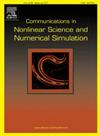具有非高斯lsamvy噪声的复杂多阶段流行病系统消光准则的改进
IF 3.4
2区 数学
Q1 MATHEMATICS, APPLIED
Communications in Nonlinear Science and Numerical Simulation
Pub Date : 2025-05-09
DOI:10.1016/j.cnsns.2025.108911
引用次数: 0
摘要
本文提出了一种分析多阶段流行病模型中灭绝条件的新方法,该方法采用随机噪声来解释影响感染传播的环境或种群水平的突然变化。通过利用一个(n+1)维摄动系统,该系统捕获了逐渐改善和比例跳跃,该研究建立了尖锐的消光标准,改进了现有文献中通常发现的假设。与依赖遍历性的经典方法不同,该框架采用了辅助方程平均解时间的矩分析,有效地解决了由于缺乏不变测度的显式表达而产生的挑战。将理论结果与先前的研究结果进行了比较,并进行了数值模拟,特别是针对艾滋病/艾滋病毒的数值模拟,以证实和加强研究结果。本文章由计算机程序翻译,如有差异,请以英文原文为准。
Refining extinction criteria in a complex multi-stage epidemic system with non-Gaussian Lévy noise
This paper proposes a new approach for analyzing extinction conditions in multi-stage epidemic models, incorporating stochastic noises to account for sudden environmental or population-level changes that influence infection transmission. By utilizing an -dimensional perturbed system that captures both gradual amelioration and proportional jumps, the research establishes sharp extinction criteria, refining the assumptions typically found in existing literature. Moving away from classical methods that rely on ergodicity, this framework employs moment analysis of the average solution time for an auxiliary equation, effectively addressing the challenges arising from the lack of an explicit expression of the invariant measure. The theoretical results are compared with those from previous studies, and numerical simulations, particularly focused on AIDS/HIV, serve to confirm and reinforce the findings.
求助全文
通过发布文献求助,成功后即可免费获取论文全文。
去求助
来源期刊

Communications in Nonlinear Science and Numerical Simulation
MATHEMATICS, APPLIED-MATHEMATICS, INTERDISCIPLINARY APPLICATIONS
CiteScore
6.80
自引率
7.70%
发文量
378
审稿时长
78 days
期刊介绍:
The journal publishes original research findings on experimental observation, mathematical modeling, theoretical analysis and numerical simulation, for more accurate description, better prediction or novel application, of nonlinear phenomena in science and engineering. It offers a venue for researchers to make rapid exchange of ideas and techniques in nonlinear science and complexity.
The submission of manuscripts with cross-disciplinary approaches in nonlinear science and complexity is particularly encouraged.
Topics of interest:
Nonlinear differential or delay equations, Lie group analysis and asymptotic methods, Discontinuous systems, Fractals, Fractional calculus and dynamics, Nonlinear effects in quantum mechanics, Nonlinear stochastic processes, Experimental nonlinear science, Time-series and signal analysis, Computational methods and simulations in nonlinear science and engineering, Control of dynamical systems, Synchronization, Lyapunov analysis, High-dimensional chaos and turbulence, Chaos in Hamiltonian systems, Integrable systems and solitons, Collective behavior in many-body systems, Biological physics and networks, Nonlinear mechanical systems, Complex systems and complexity.
No length limitation for contributions is set, but only concisely written manuscripts are published. Brief papers are published on the basis of Rapid Communications. Discussions of previously published papers are welcome.
 求助内容:
求助内容: 应助结果提醒方式:
应助结果提醒方式:


